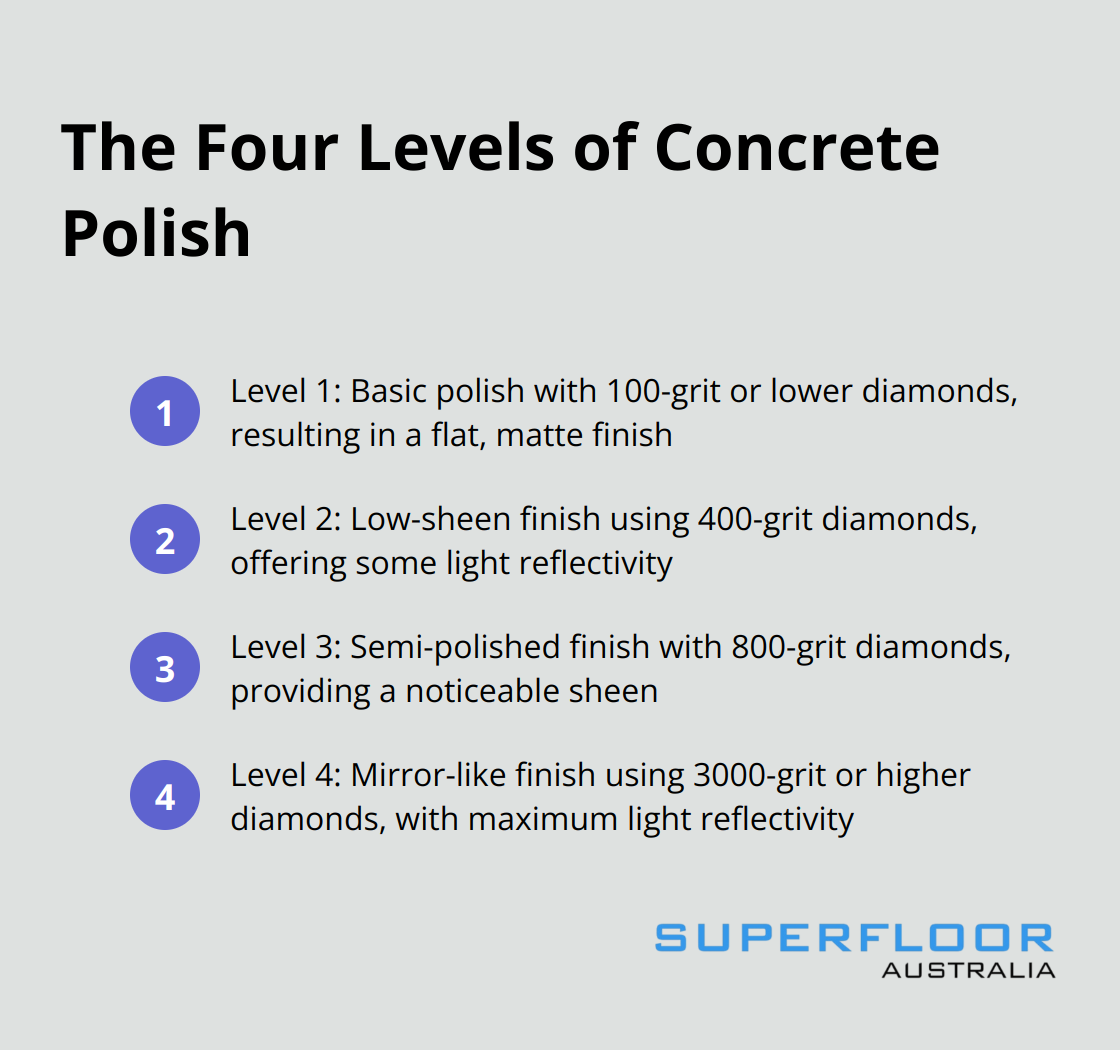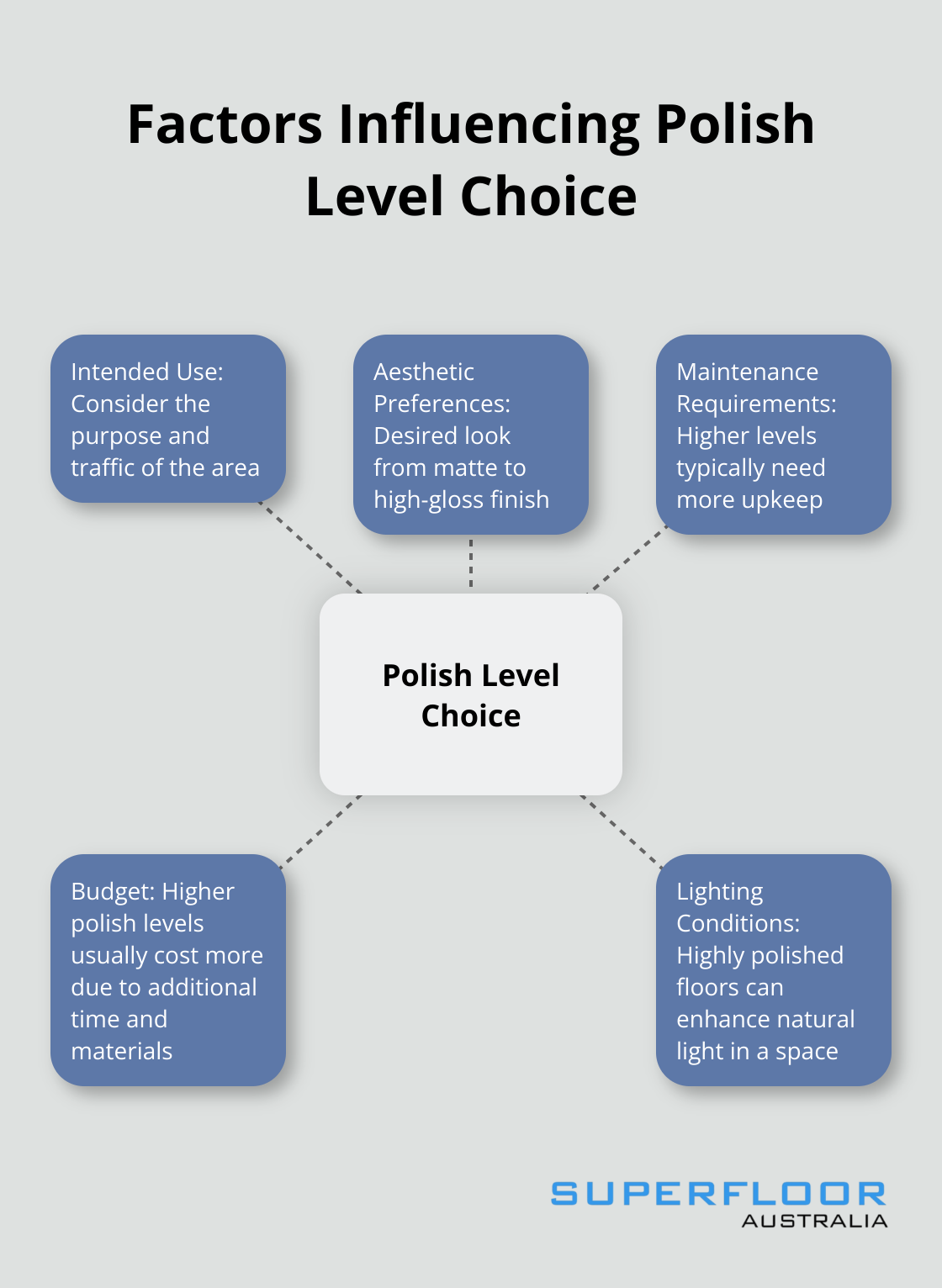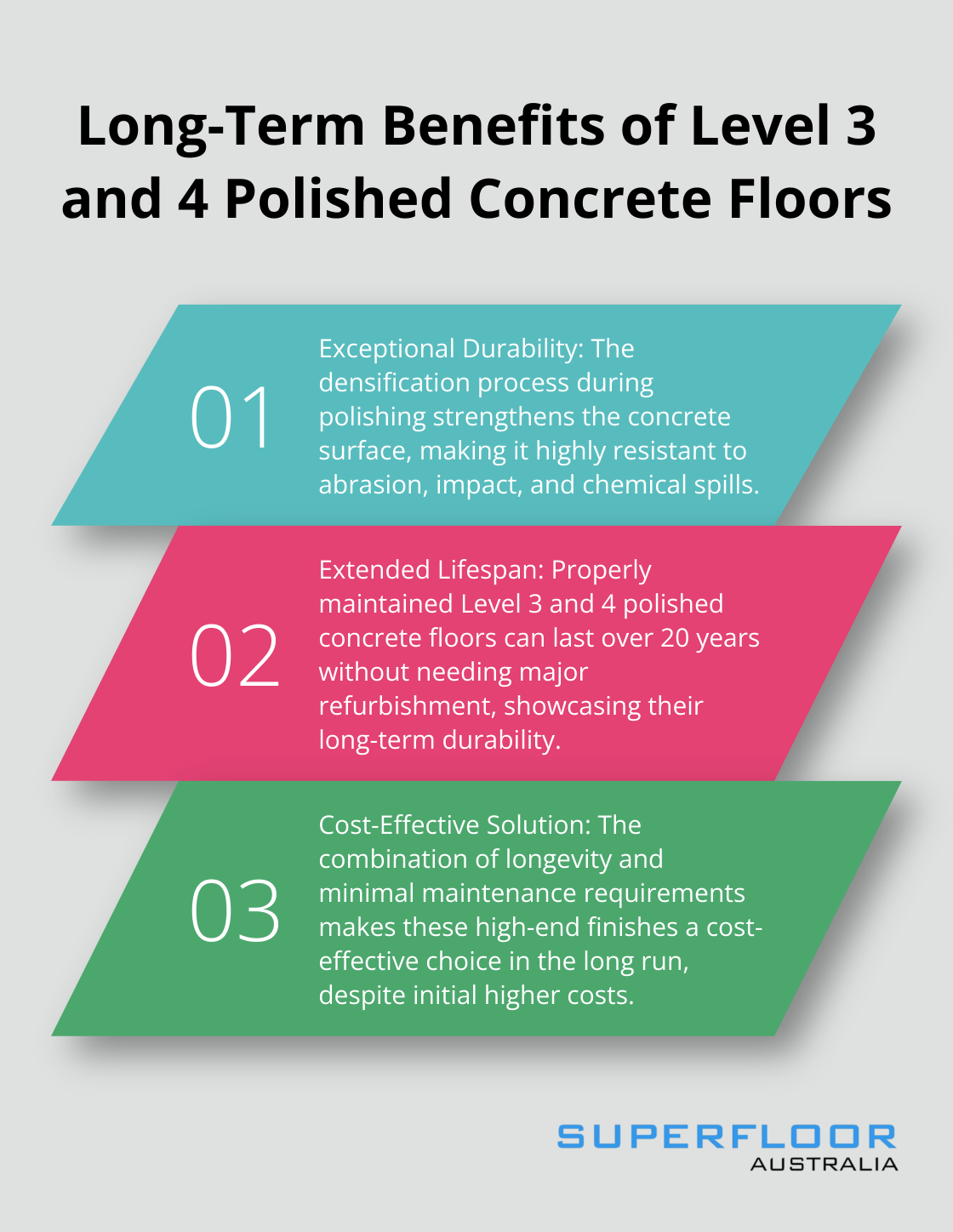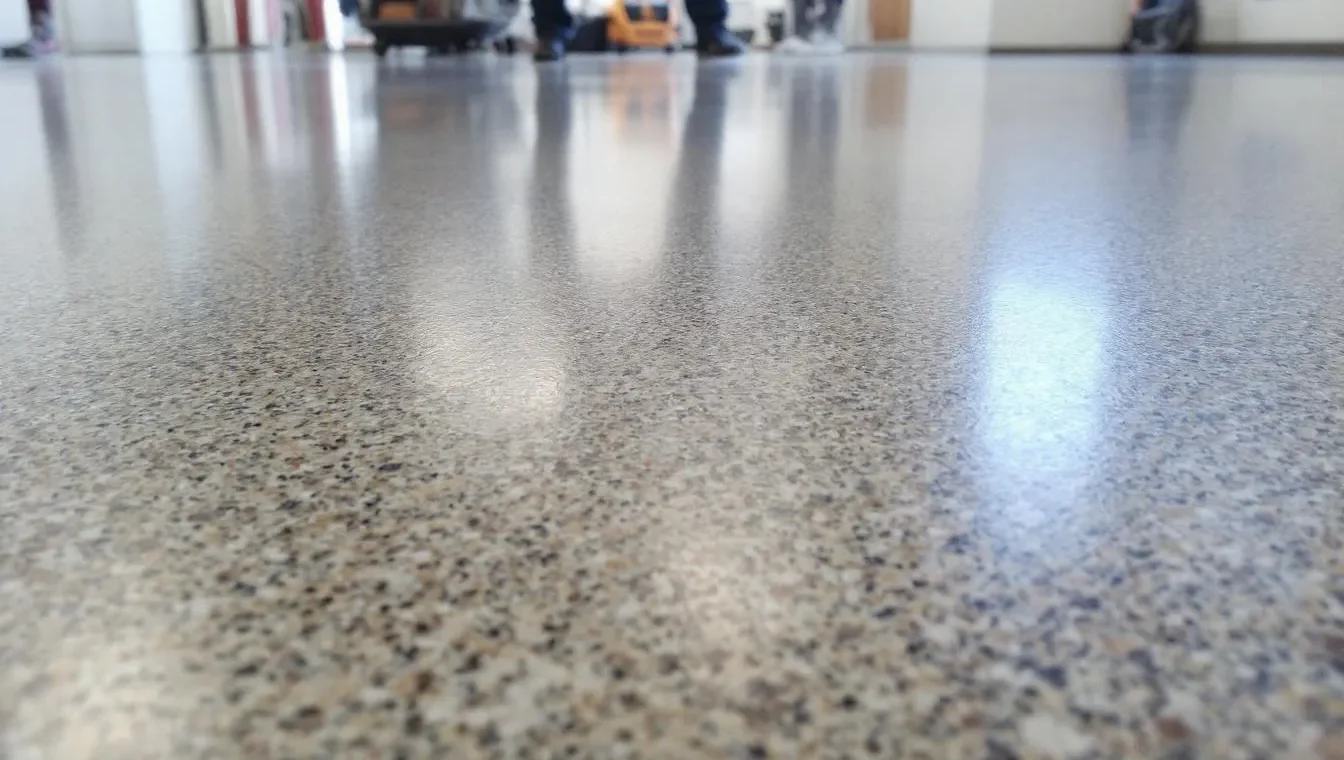Concrete polishing levels can significantly impact the appearance and functionality of your floors. At Superfloor Australia, we’ve seen first-hand how choosing the right level transforms spaces.
This guide will walk you through the different concrete polishing levels, from basic to high-end finishes. We’ll explore their characteristics, applications, and maintenance requirements to help you make an informed decision for your project.
What Are Concrete Polishing Levels?
The Art of Concrete Polishing
Concrete polishing transforms ordinary concrete into a smooth, glossy surface. This multi-step process uses progressively finer grits of diamond tools to achieve the desired level of shine. At Superfloor Australia, we have honed this technique to create stunning floors for various settings.
The Four Levels of Concrete Polish
Concrete polish comes in four distinct levels, each offering a unique finish:
- Level 1: The most basic polish (achieved with 100-grit or lower diamonds) results in a flat, matte finish with minimal light reflection. Industrial settings often prefer this level where functionality outweighs aesthetics.
- Level 2: This level (using 400-grit diamonds) produces a satin or low-sheen finish. It offers some light reflectivity and is popular in retail spaces and offices.
- Level 3: A semi-polished finish (created with 800-grit diamonds) provides a more noticeable sheen. High-end commercial spaces often choose this level.
- Level 4: The highest level of polish (achieved with 3000-grit or higher diamonds) results in a mirror-like finish with maximum light reflectivity. Upscale residential or commercial settings often showcase this level.

Factors Influencing Polish Level Choice
Several factors influence the selection of the right polish level:
- Intended Use: High-traffic areas may benefit from higher polish levels for increased durability.
- Aesthetic Preferences: The desired look (from matte to high-gloss) will guide the choice of polish level.
- Maintenance Requirements: Higher polish levels typically require more maintenance to preserve their shine.
- Budget: Higher polish levels usually cost more due to additional time and materials required.
- Lighting Conditions: Highly polished floors can enhance natural light in a space (a consideration in areas with limited natural illumination).

Measuring Polish Levels
The Concrete Polishing Association of America provides quantifiable data to differentiate between polish levels. A gloss meter measures the polish level, with readings ranging from low gloss (20-30) to high gloss (70-80). Level 2 polish typically scores between 40 and 50, while Level 4 finish usually ranges from 60 to 80.
These measurements help clients understand the visual difference between polish levels and make informed decisions about their flooring. The next section will explore the characteristics and applications of Level 1 and 2 polishing in more detail.
Level 1 and 2 Polishing: The Basics
Level 1 Polishing: Industrial Strength
Level 1 polishing creates a flat, matte finish using 100/200 grit abrasives. This finish excels in industrial settings where function outweighs form. The surface offers minimal light reflection, making it ideal for warehouses, factories, and high-traffic areas that require slip resistance.
The cost-effectiveness of Level 1 polishing stands out as a key advantage. It demands fewer grinding passes, which reduces labour and material costs. However, while Level 1 polishing enhances concrete durability, it doesn’t provide the same stain resistance as higher polish levels.
Level 2 Polishing: Versatile Appeal
Level 2 polishing produces a low-sheen finish with 400-grit diamond abrasives. This level balances aesthetics and practicality, making it popular for retail spaces, offices, and schools. The surface reflects some light, brightening the space without creating a mirror-like effect.
The versatility of Level 2 polishing sets it apart. It offers a more refined look than Level 1 while maintaining excellent slip resistance. This makes it suitable for areas with moderate foot traffic that require a professional appearance.
Maintenance and Longevity
Maintaining Level 1 and 2 polished concrete requires minimal effort. Regular dust mopping and occasional damp mopping with a pH-neutral cleaner usually suffice. For Level 2 floors, periodic use of a burnishing machine can maintain the sheen.
The longevity of these finishes depends on factors such as foot traffic and chemical exposure. One of the key factors that can affect the lifespan of polished concrete floors is the condition of the underlying concrete slab.
Choosing Between Level 1 and 2
The choice between Level 1 and 2 polishing depends on several factors:
- Intended use of the space
- Desired aesthetic (matte vs. low-sheen)
- Budget constraints
- Maintenance preferences
- Lighting conditions in the area
For industrial spaces prioritising function and cost-effectiveness, Level 1 polishing often proves the best choice. For environments balancing aesthetics and practicality (like retail stores or offices), Level 2 polishing typically offers the ideal solution.
As we move forward, we’ll explore the characteristics and benefits of Level 3 and 4 polishing, which provide even higher levels of shine and durability for those seeking a truly high-end finish.
Level 3 and 4 Polishing: The High-End Finish
The Pinnacle of Concrete Polishing
Level 3 and 4 polishing represent the highest echelons of concrete finishing. These premium levels offer unparalleled shine and durability, transforming ordinary concrete into extraordinary surfaces.
Level 3 Polishing: The Semi-Polished Sheen
Level 3 polishing (achieved with 800-grit diamond abrasives) produces a semi-polished finish with noticeable light reflectivity. This level strikes a balance between high-end aesthetics and practicality, making it a popular choice for upscale commercial spaces, high-end retail stores, and luxury residential properties.
The semi-polished surface of Level 3 concrete offers enhanced stain resistance compared to lower levels. This makes it particularly suitable for areas prone to spills or heavy foot traffic. Matte surfaces (Level 1-2) reduce glare in high-traffic areas, while reflective options (Level 3-4) amplify natural light but require more upkeep.
Level 4 Polishing: The Mirror-Like Finish
Level 4 polishing (achieved with 3000-grit or higher diamond abrasives) creates a mirror-like finish with maximum light reflectivity. This ultra-high-gloss surface is the epitome of luxury and sophistication, often found in high-end hotels, corporate headquarters, and exclusive residential properties.
The reflective properties of Level 4 polished concrete can significantly enhance the lighting in a space.
Long-Term Benefits and Durability
Both Level 3 and 4 polished concrete floors offer exceptional durability and longevity. The densification process during polishing strengthens the concrete surface, making it highly resistant to abrasion, impact, and chemical spills.
Properly maintained Level 3 and 4 polished concrete floors can last over 20 years without needing major refurbishment. This longevity (combined with minimal maintenance requirements) makes these high-end finishes a cost-effective choice in the long run.

Maintenance Requirements
Maintenance for these premium levels involves regular dust mopping and occasional damp mopping with pH-neutral cleaners. For Level 4 floors, periodic use of a high-speed burnisher can help maintain the ultra-high gloss finish.
When you consider Level 3 or 4 polishing, it’s important to work with experienced professionals. The expertise required for these high-end finishes is significant, and the quality of the final result depends heavily on the skill of the installers.
Final Thoughts
Concrete polishing levels offer a spectrum of finishes, each with unique characteristics and benefits. From the basic matte finish of Level 1 to the mirror-like sheen of Level 4, these options cater to diverse needs and preferences. The right level impacts visual appeal, functionality, maintenance requirements, and long-term durability of your space.
We at Superfloor Australia understand the nuances of concrete polishing levels and their applications. Our expertise in delivering high-quality polished concrete flooring in Brisbane ensures we can guide you towards the best solution for your specific needs. We offer a comprehensive range of solutions, from enhancing the natural beauty of concrete through honing to creating slip-resistant surfaces for outdoor areas.
Superfloor Australia provides durable, aesthetically pleasing, and low-maintenance surfaces that will stand the test of time. Our commitment to precision preparation and expert craftsmanship guarantees lasting results tailored to your individual requirements. Contact us today to transform your concrete floors into stunning, functional surfaces.
